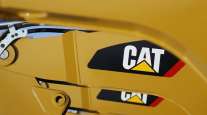Caterpillar’s All-Seeing Sensors Steady Profit in Downturn

Caterpillar Inc. is using cost-cutting logistics to keep profits steady during the commodities meltdown.
Sales at the world’s biggest machinery producer have declined in the past three years as its customers cut back on drilling, mining and building. But all the while, one of the company’s key gauges of profitability — gross margin — has remained relatively steady during a period it has called its longest downturn ever.
“If gross margin goes up when volumes are down so much, it does show they are making progress” in improving the company’s cost structure, Karen Ubelhart, a New York-based analyst at Bloomberg Intelligence, said in an interview.
Caterpillar, which analysts estimate will report second-quarter profit of 96 cents a share July 26, has kept earnings from evaporating by shutting less-profitable factories and cutting 10,000 workers through 2018. That has steadied its gross margin, though the gauge is estimated to have fallen to 25.4% in the second quarter from 27.7% a year earlier.
Less publicized is that the company, known for its signature yellow trucks and excavators, also is reinventing its network connecting suppliers and customers.
The focal point of that initiative is based in a building about 15 miles up the Illinois River from its Peoria headquarters in what Caterpillar calls the “Assurance of Supply Center.”
In windowless offices, technicians oversee a patent-protected system that monitors many of Caterpillar’s global operations. The team is tasked with assuring that drivers transporting bulldozers across the United States, for instance, aren’t slowed by a delayed trucking permit at a state line, or a freighter carrying large machines out of China isn’t stymied by port congestion in Shanghai.
Frank Crespo, Caterpillar’s chief procurement officer, began working on the system when he joined the company in 2010. Starting in 2012, his team spent about three years installing sensors on delivery vehicles and reworking contracts with suppliers to give Caterpillar control — and visibility — over deliveries.
Now Crespo’s team can monitor almost everything Caterpillar buys and distributes. If a factory has a fire, such as the one in 2015 that shut the company’s facility in Gosselies, Belgium, Crespo can find out instantly how many of that factory’s product — wheel loaders — exist in other parts of the Caterpillar system, and how many can be built with parts that are ready to be assembled elsewhere. In that case, Caterpillar held off on boosting output at other plants because Crespo was able to determine the factory would be running again before the pipeline was depleted.
“If we’re going to transform the network, we have to transform human behavior,” Crespo said in an interview at the center in Mossville, Illinois. “We can’t do that without granular data.”
While these kinds of systems have been commonplace for companies such as chipmakers, Caterpillar is unique among large industrial companies, whose long lead times and global supply and distribution networks magnify its complexity, said David Simchi-Levi, a professor of civil and environmental engineering at the Massachusetts Institute of Technology.
“Just common sense, experience and intuition is not enough,” Simchi-Levi, who worked as a consultant on Caterpillar’s logistics network, said in an interview. “You have to complement them with data.”
The efficiency program has helped the company weather monthly retail sales declines for more than three years. In that time, its gross margin — which represents the portion of each dollar of revenue the company retains as profit — has held steady and even rose by about 1.5 percentage points from 2013 to last year.
“In the old days, they used to lose money in a downturn,” Stephen Volkmann, a New York-based analyst at Jefferies, said by phone. “Now they’re making pretty good money, even in a pretty bad downturn.”




